#Spatial Data Services
Explore tagged Tumblr posts
Text
Location Intelligence Siemens
Transform Your Business with Location Intelligence: Unlock the Power of Geospatial Insights
Location Intelligence empowers organizations to make data-driven decisions by providing actionable insights derived from geospatial data. By integrating location-based analytics into your operational processes, you can enhance efficiency, improve customer engagement, and drive strategic growth.
Contact us at:
+65 6428 6222
#Location Intelligence Solutions#GIS Analytics#Spatial Data Services#Location-Based Insights#Geospatial Technology#Geo-Visualization#Data-Driven Mapping#Advanced GIS Platform#Geospatial Analytics
0 notes
Text

Enhancing Gas Pipeline Management with GIS: Key Benefits and Applications
In the energy and utilities sector, gas pipeline management is complex, requiring precision, safety, and a clear strategy for both existing infrastructure and future expansion. Geographic Information Systems (GIS) have revolutionized pipeline management by providing a spatially accurate, data-rich view of assets. From asset management and leak detection to route planning and demand forecasting, GIS is becoming indispensable for gas companies. This blog delves into the ways GIS transforms gas pipeline management, delivering benefits across safety, efficiency, cost-saving, and planning.
#benefits of using gis for gas pipelines#ensuring gas pipeline safety with gis tools#gas network analysis#gas pipeline asset management#gas pipeline gis mapping services#gas pipeline leak detection using gis#gas pipeline management in gis#gas pipeline mapping software#gas pipeline monitoring tools#gas pipeline risk assessment#gis applications in energy sector#gis for gas pipeline monitoring#gis for infrastructure management#gis in oil and gas industry#gis pipeline maintenance software#gis pipeline monitoring system#gis pipeline route planning#gis software for gas pipeline route optimization#victoryofgoodoverevil#gis solutions for pipeline maintenance and monitoring#gis-based pipeline integrity management#pipeline data management#pipeline geographic information systems#pipeline management solutions#remote sensing for gas pipelines#spatial analysis for gas pipelines#spatial data for gas pipelines
0 notes
Text
What is Dataflow? Part 3: Doing the Practical
Apologies for the delay in getting this next section up - past few weeks have been super busy and then, hilariously, I was ill last week.
Read Part 1 here.
Read Part 2 here.
In Part 2 I wrote about how important diagrams have been throughout history. Understanding the 'big picture' has been important for every triumph of engineering. From bridges to skyscrapers to oil rigs and wind turbines, all of these have had diagrams backed by international standards which enabled them to be built.
The digital world hasn't quite managed that yet. In the other posts I've tried to drill home the point that modern digital businesses are often extremely siloed, communication and documentation isn't there and there is a lack of a common language between 'Business' and 'IT'.
This lack of understanding means organisations do not understand how data flows through their business and their supply chain.
It's the understanding of dataflow that's important here because it enables organisations to focus on optimising, securing and maintaining flows across an organisation rather than siloed teams patching things up where they can and not understand the upstream and downstream impact on the business.
Method and Layers
Going to preface this by saying that this may come across as complete common sense, and to some extent you'll be completely correct!
This is an example of how to create a very basic dataflow. But I will first start with understanding all of the People, Processes and Technology that I use to post on Tumblr.
So I start with six layers:

Ownership
Business Process
Application
System
Hardware
Infrastructure
What is important to remember here is that you do not have to be a specialist in every single layer.
A Business Analyst will feel much more at home in the Business Process Layer, while an Infrastructure Manager will be much more knowledgeable about the Infrastructure layer.
The important thing is that this Business & IT Diagram allows them to communicate more efficiently.
Let's Build a Dataflow!

In this example - There's an 'AyeforScotland' Element (the rectangle!) at the top. I'm the owner of everything below that element. The black lines are 'connections' representing the connectivity between the different elements.
Following the example, I'm responsible for' managing my blog 'Blog Management' which breaks down into smaller processes: Draft posts, schedule posts, answer anon abuse, and reblog shitposts.
Coming down to the Application Layer (red) - You can see that I draft and schedule posts using Tumblr Desktop and I'm using Firefox Web Browser for that.
But for answering anon abuse and reblogging shitposts, I'm using the Tumblr App.
In the Systems layer you can see I'm using Windows 11 on my PC (Hardware) and I'm using iOS on my iPhone.
Both my PC and iPhone connect to my BT Router.
And that's it for this Business & IT Diagram. I've shown clearly how I'm responsible for the processes and how I use the technology to perform those processes. I don't necessarily need to show everything on a single diagram because it would lose clarity.
This next Business & IT Diagram is much smaller, and establishes the relationships and dependencies on Tumblr to provide the service. And that's because we're complying with the laws and rules of a methodology.

In this diagram (probably need to zoom in to see it) I'm at the top left as 'AyeforScotland' and my 'BT Router' is spatially below me. Following the rules and laws of the method, that maintains the relationship that I have with the BT Router, I own it.
But I don't own the small 'Internet' that's next to it horizontally. I've simplified the concept of the internet for this example.
There's also two owners - 'Automattic' which owns and operates 'Tumblr' below it, with Tumblr being responsible for the 'Provision of Tumblr Services'.
Now naturally 'provision of Tumblr services' will break out into loads of sub-processes. Tumblr could map out their entire organisation (and if they need a hand, they can DM me!) But for this dataflow it's not really required.
Now both diagrams above are not dataflows. But close your eyes for a second and you can visualise what they are.
But because we've created our two diagrams, we understand the connectivity and using the software we can create the dataflow.

Now again, this is very basic. But when you put things into a dataflow context, you can put this down in front of a wide range of people from different business disciplines and they can start to optimise how the business works.
Here's a much larger Dataflow example, that you won't be able to read because it exceeds A0 printing size, but it should convey the scale.

If any of the connections or elements fail along this dataflow - The dataflow stops.
This costs organisations time and/or money.
So understanding dataflows allows IT people to articulate to business people "Hi boss, if this server goes down it will bring down this dataflow and cost the business $10,000 an hour" - Suddenly it's in a language they understand.
It helps with strategic decision-making, it helps with communication, it helps document how things *actually* work as opposed to how people think they work, and once you switch to thinking in terms of 'dataflow' it's hard to stop.
Conclusion
I can't wait to answer all the questions on the back of this.
Also one area I didn't go into is that each of the elements (rectangles) can also hold data (Financial data, Technical Specs, Risk & Cybersecurity metrics, Governance documentation etc).
It's also really easy to get started with it. You can start in any of the layers based on your area of work.
195 notes
·
View notes
Text

Meteosat-12 begins prime service duty
A new chapter in European weather and climate monitoring begins as EUMETSAT's Meteosat-12 satellite, formerly Meteosat Third Generation (MTG) Imager 1, takes up the baton from Meteosat-10 to deliver Europe's prime data service from geostationary orbit.
Orbiting at an altitude of around 36,000 kilometers, Meteosat-12 is the first imaging satellite in the MTG program and now moves into its key position above the equator at 0° longitude, directly over the Gulf of Guinea.
From its lofty vantage point, Meteosat-12 is now the main source of near-real-time geostationary satellite data for Europe, Africa and the surrounding oceans. Data from its instruments are distributed to national meteorological services in EUMETSAT member states and beyond, with improved detail and timeliness—as well as new observations such as lightning data—giving weather forecasters additional confidence in their predictions.
Phil Evans, Director-General of EUMETSAT, said, "Meteosat-12 now takes responsibility for delivering Europe's prime geostationary satellite service, ensuring continuity and delivering enhanced capabilities at a time when severe weather events are becoming more frequent due to the climate crisis.
"The MTG system marks a new era in weather forecasting, providing data that support everything from improving severe weather warnings and enhancing transport safety to wildfire response and air quality hazard assessments.
"Once the full MTG constellation is operational, it will, for the first time, allow us to observe the entire lifecycle of a convective storm—from the earliest signs before clouds begin to form to the detection of lightning strikes. These data help forecasters, emergency services, and civil authorities respond more rapidly and effectively to protect lives, property, and infrastructure."
Launched on 13 December 2022, Meteosat-12 scans the full Earth disk every 10 minutes, delivering data more frequently and in sharper detail than its predecessor. It carries two main instruments: the Flexible Combined Imager (FCI) and Lightning Imager (LI).
The FCI delivers imaging data in twice as many spectral channels than its predecessor and with an improved spatial resolution, providing more detailed views of fast-changing weather such as storms, fog, and rapidly forming clouds.
The satellite also carries the LI, Europe's first space-based instrument to detect lightning across Europe and Africa, day and night, helping forecasters assess storm development, intensity, and risk.
The MTG program will run into the 2040s and includes six satellites: four imagers and two sounders. The first MTG sounder, MTG-S1, will launch in summer 2025 and provide vertical profiles of temperature and humidity from geostationary orbit—another first for Europe.
Combined with data from MTG imagers and next-generation Metop satellites, it will enhance short-range forecasting by enabling specialists to track storms throughout their entire lifecycle and supplying data to further enhance weather models.
As EUMETSAT deploys the MTG satellites, those of the Meteosat Second Generation will continue to play an important role in EUMETSAT's constellation for years to come.
Meteosat-10 will now assume a supporting role, continuing imaging services as a ready backup for Meteosat-12. Meteosat-11 delivers rapid scans every five minutes over Europe and North Africa and can also support the prime service if needed. Meteosat-9 remains positioned over the Indian Ocean, providing vital data to regions vulnerable to cyclones and monsoons.
Gareth Williams, Head of Flight Operations at EUMETSAT, said, "Meteosat-12 now provides the prime service within a coordinated constellation of satellites that ensures continuity, reliability and resilience, while introducing important new capabilities.
"Seeing the spacecraft take responsibility for Europe's prime geostationary service is a major operational achievement, reflecting years of dedicated work across EUMETSAT, our member states and partners. With more MTG satellites to come, we look forward to an even greater impact from the constellation in delivering vital data for forecasting, climate monitoring and other essential services and applications."
IMAGE: Meteosat-12 is part of the Meteosat Third Generation programme, Europe’s new fleet of geostationary meteorological satellites. Credit: European Organisation for the Exploitation of Meteorological Satellites (EUMETSAT)
2 notes
·
View notes
Text
3D Laser Scanning: Services for Mining & Civil Projects

MDM Mining Civil offers advanced 3D Laser Scanning services to deliver precise, high-resolution surveys for mining and civil engineering projects. Our cutting-edge technology captures detailed spatial data quickly and efficiently, ensuring accurate site analysis, design, and planning. Using cutting-edge 3D laser scanning technology, we capture highly detailed and accurate data of physical spaces and objects. This technique allows us to create precise models and visualisations, ideal for complex projects that require meticulous planning and design. For more information, visit us at https://www.mdmminingcivil.com.au/surveying
2 notes
·
View notes
Text
Population growth & rail stations need better alignment in Atlanta
Darin Givens | April 10, 2024
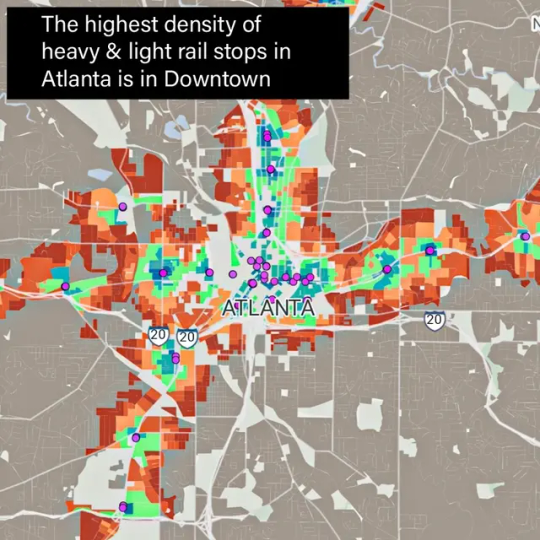
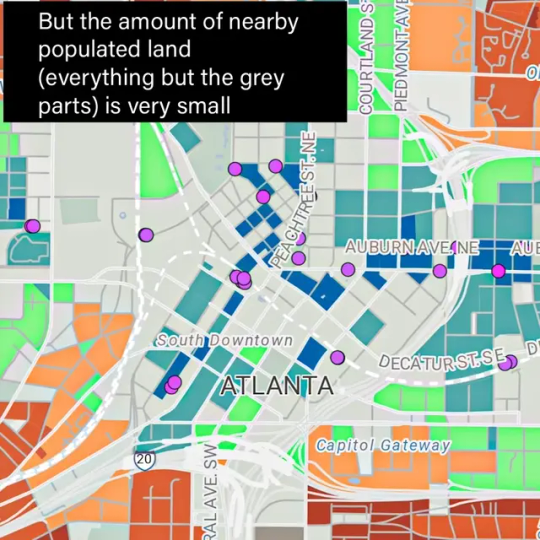
Check out the maps above. They clearly show that the highest density of light rail & heavy rail stops in Atlanta is in Downtown, but that only a small amount of land near those stops is populated by any level of residential development.
This is data that we likely already knew, but seeing it mapped out so clearly is impressive. And it should make us think about whether we're doing all we can to make the best use of our biggest investments in rail.
As we've found out the hard way over the last 30 years, building new rail lines or infill stations is incredibly expensive and doesn't happen quickly (the last rail line MARTA built was the one to North Point Station which opened in 2000).
We shouldn't stop planning for expansion of rail, such as the line promised for the Beltline, but making the best use of land near our existing rail service is at least as crucial as expansion.
Our track record is grim. Many parking lots and empty buildings sit within a couple of blocks of the Atlanta Streetcar tracks. And this, below, is the blighted area surrounding Garnett MARTA Station in Downtown.
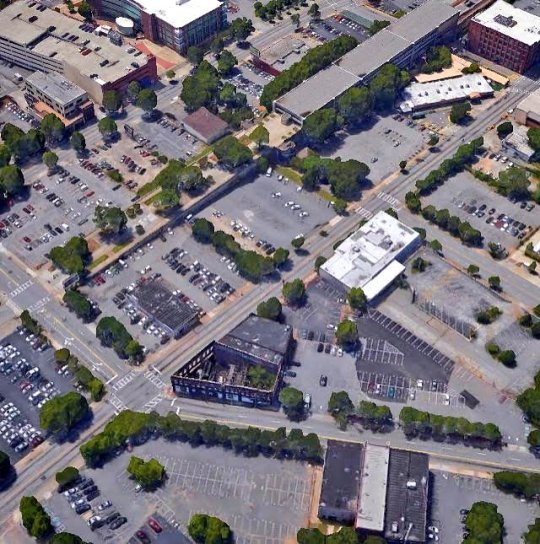
Matching development -- with a big dose of residential density -- with our rail stations is common sense, Urbanism 101 stuff. It shouldn't be as hard as we've made it out to be in Atlanta. We can and must do better.
These maps at the top of this post were made with an impressive mapping tool, Close.city at www.close.city
The tool was built by Henry Spatial Analysis in Seattle. It lets you create walkability maps of various data points such as supermarkets, libraries, transit stops, and more.
14 notes
·
View notes
Text
"Building the Future: How 15-Minute Cities Can Transform India’s Urban Landscape"
India is fast emerging as a new land of opportunity, with many suggesting that the 21st century will witness a shift in the global order, placing India at the forefront. The government’s focus on infrastructure is a testament to this, as seen in the capital investment outlay of ₹11,11,111 crore in the 2024-25 budget—an impressive 11.1% increase from the previous year, making up 3.4% of the GDP. This substantial boost reflects the nation’s commitment to building a stronger, more resilient future.
However, it’s hard to ignore the strain on our cities, which feel like they are bursting at the seams, inching closer to an infrastructural tipping point. Many of these cities, built during colonial times, lack the fundamental urban planning or modern mapping needed for today’s demands. While there is no magical solution to these deeply rooted issues, and India—being a land of unique needs and adaptations—will never find a one-size-fits-all answer, it is a country that embraces innovation and customizes it to its own needs. But I digress.
The purpose of this piece is not to assign blame but to highlight potential solutions. One solution that shines through is the concept of 15-minute cities. A 15-minute city is designed so that all essential services—schools, healthcare, parks, financial institutions—are no more than a 15-minute commute by road.
Imagine a world where your daily commute takes no longer than 15 minutes. It’s a vision that not only promises work-life balance but also offers a much-needed environmental reprieve, with reduced fuel consumption and fewer emissions. The benefits of such a model are numerous:
Reduced Traffic Congestion: With less reliance on cars, traffic eases, resulting in shorter commute times, improved well-being, and a healthier work-life balance.
Cleaner Environment: Fewer cars on the road mean lower air pollution, contributing significantly to combating climate change.
Health and Social Bonds: Walking and cycling are encouraged, boosting physical health and strengthening social ties within the community.
Thriving Local Businesses: As people stay closer to home, local businesses flourish with increased foot traffic, creating a vibrant neighborhood atmosphere. Economic activity spreads evenly across the city, breathing new life into shops and services beyond central hubs.
Easier Access to Services: Essential services like schools, healthcare, and groceries become easily accessible, fostering inclusivity and easing the strain on public transportation.
Fostering Inclusion: This model ensures that no matter where someone lives, they have access to the same opportunities, creating a more inclusive and equitable city.
Resilience in Crises: A decentralized structure, with services spread throughout, helps cities adapt more effectively to challenges like pandemics or natural disasters.
GIS (Geographic Information Systems) plays a pivotal role in bringing the 15-minute city concept to life. By mapping out urban areas and analyzing spatial data, GIS helps planners identify where essential services are lacking and where improvements can be made. It enables efficient zoning, optimal placement of resources, and real-time monitoring of traffic patterns or environmental impacts. In a country like India, where cities are complex and densely populated, GIS offers a smart, data-driven approach to designing walkable neighborhoods, ensuring that every community has access to the amenities they need.
Admittedly, there are challenges. Implementing this in densely populated areas can be complex, potentially leading to gentrification and rising property values, which could displace lower-income residents. Additionally, some might resist the shift from car-dependent lifestyles. There is also the concern of limited job diversity within such a localized area. Yet, with the rise of remote work, job opportunities are increasingly flexible and accessible, allowing this issue to be overcome.
In India, where close-knit families and social networks often span across neighborhoods, this connectivity remains intact even as local living is prioritized. By creating more livable, walkable spaces, the 15-minute city model champions sustainability and inclusivity while addressing the ever-evolving demands of urban life.
In conclusion, while no solution is without its challenges, the 15-minute city offers a pathway toward more balanced, resilient, and harmonious urban living. As India continues to rise, this model could be a blueprint for a future where well-being, community, and sustainability take center stage in our cities.
6 notes
·
View notes
Text
The Hidden Cost of Convenience: How Your Smart Devices Are Mapping Your Life

In an era where smart devices have become ubiquitous in our homes, a disturbing reality lurks beneath their convenient features. Is that robot vacuum diligently cleaning your floors? It's creating detailed 3D maps of your home. The biometric scanner at your local grocery store? It's collecting more than just payment data. These revelations come from data privacy experts Aram Senriq and Jesse Gilbert, authors of "The Secret Life of Data," who warn that our digital footprints are far more extensive – and permanent – than most people realize. "Data isn't really an object so much as it's a frame of mind," explains Senriq. "You can take any aspect of the human experience and reduce it to a set of numbers that has value for somebody somewhere." Take Amazon's Roomba, for instance. While marketed as a simple vacuum cleaner, its LIDAR sensors create comprehensive 3D maps of your home's interior, tracking everything from furniture placement to the number of residents and pets. According to Gilbert, this data has value far beyond improving cleaning efficiency. "The vacuuming function is why we invite them into our homes, but it's not the value for Amazon," he notes. This detailed spatial data helps build sophisticated consumer profiles that can be packaged and sold to third parties – or potentially accessed by government agencies without a warrant. The implications extend beyond individual privacy concerns. Amazon's acquisition of One Medical and its collection of biometric data through Whole Foods' palm-scanning payment system creates an unprecedented intersection of consumer behavior and health data. "Correlating your shopping habits with your medical risk factors... are very consequential and very high stakes," Gilbert warns. Even more troubling is how today's innocent data collection could have tomorrow's unforeseen consequences. The authors point to a stark example: during the decades when abortion was legal nationwide, millions of Americans used Google Maps to locate healthcare clinics. Post-Roe v. Wade, that same location data could potentially be used as evidence in criminal proceedings in states where abortion is now illegal. So what can consumers do? While completely opting out of digital services isn't realistic for most people, the authors suggest a three-pronged approach: - Support federal data privacy legislation - Take practical steps like using VPNs to encrypt personal data - Foster a culture of privacy awareness and normalized protective behaviors The message is clear: We need to move beyond the "nothing to hide" mindset and recognize that all data, like DNA, exists as part of an interconnected web that can reveal far more about us—and those connected to us—than we might imagine. As our homes and lives become increasingly connected, the question isn't just about what data we're willing to share today, but how that data might be used tomorrow. The convenience of smart devices comes with a price tag we're only beginning to understand. Read the full article
2 notes
·
View notes
Text
GIS In Our Daily Lives
The involvement of Geographic Information Systems (GIS) in our daily lives is pervasive, influencing and enhancing various aspects across different sectors. The integration of GIS into everyday activities has become integral for decision-making, planning, and optimizing resources. GIS helps city planners and transportation experts to provide them with information like maps, satellite pictures, population statistics, and infrastructure data. GIS helps them make better decisions when designing cities and transportation systems that are sustainable and good for the environment.
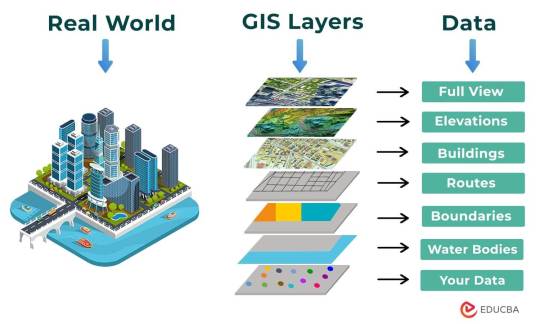
The following points elucidate the notable involvement of GIS in our daily lives:
Navigation and Location Services: GIS provides monitoring functions through the visual display of spatial data and precise geographical positioning of monitored vehicles, whereas GPS provides accurate, clear, and precise information on the position and navigation of a monitored or tracked vehicle in real-time and at the exact location.GIS is at the core of navigation applications and location-based services on smartphones. It enables accurate mapping, real-time navigation, and geolocation services, assisting individuals in finding locations, planning routes, and navigating unfamiliar areas.
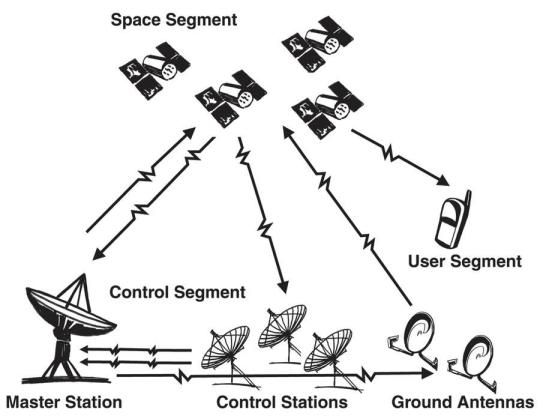
E-Commerce and Delivery Services: GIS software is a powerful tool for supply chain network planning. It helps determine the optimal location for distribution centers, warehouses, or other supply facilities. GIS is utilized in logistics and delivery services for optimizing routes, tracking shipments, and ensuring timely deliveries. E-commerce platforms leverage GIS to enhance the efficiency of their supply chain and last-mile delivery processes.
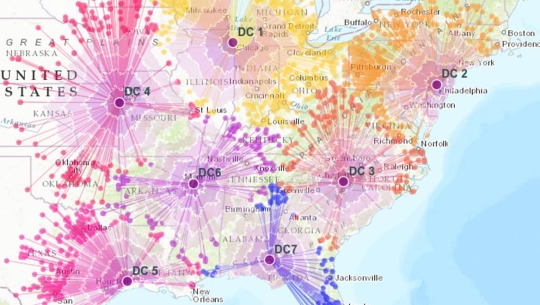
Weather Forecasting and Disaster Management: Many states are using GIS dashboard to monitor the rainfall across the state, on a real-time basis, from the data shared by rain sensors installed at various locationsGIS plays a crucial role in weather forecasting and disaster management. It assists meteorologists in analyzing spatial data, predicting weather patterns, and facilitating timely responses to natural disasters by mapping affected areas and coordinating emergency services.
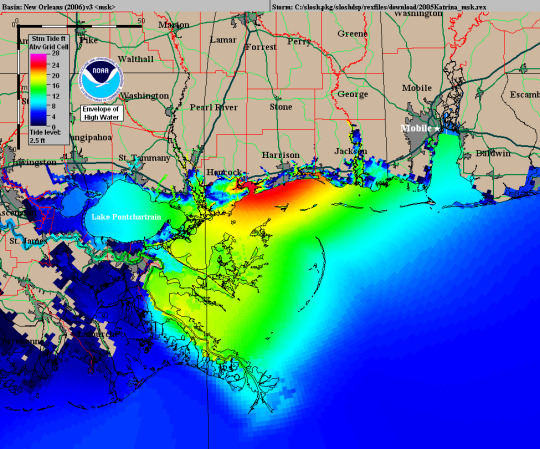
Healthcare Planning and Disease Monitoring: Geographic Information Systems enable the visualization and monitoring of infectious diseases. Additionally GIS records and displays the necessary information that health care needs of the community as well as the available resources and materials. GIS supports public health initiatives by mapping the spread of diseases, analyzing healthcare resource distribution, and assisting in the planning of vaccination campaigns. It aids in identifying high-risk areas and optimizing healthcare service delivery.
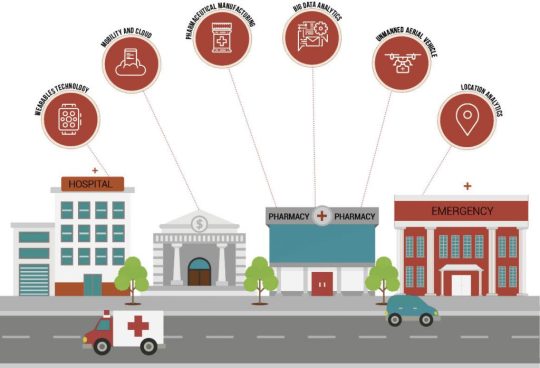
Social Media and Geo-tagging: GIS also helps in geotagging and other location related information in posts, it’s tools can map and visualize the spatial distribution of social media activity. This analysis can reveal trends, hotspots, and patterns in user engagement across different geographic areas. Many social media platforms incorporate GIS for geo-tagging, allowing users to share their location and experiences. This feature enhances social connectivity and facilitates the sharing of location-specific information.
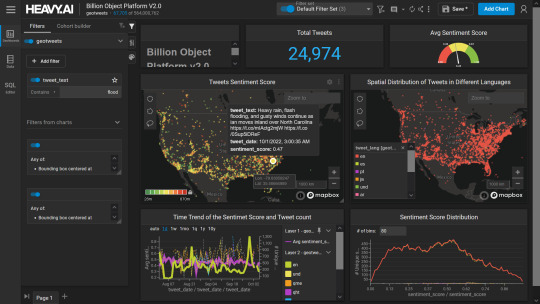
Smart City Initiatives: The Geographic Information System (GIS) offers advanced and user-friendly capabilities for Smart City projects and allows to capture, store and manipulate, analyze and visualize spatially referenced data. It is used for spatial analysis and modeling. It is the cornerstone of smart city planning, enabling the integration of data for efficient urban management. It supports initiatives related to traffic management, waste disposal, energy consumption, and overall infrastructure development.
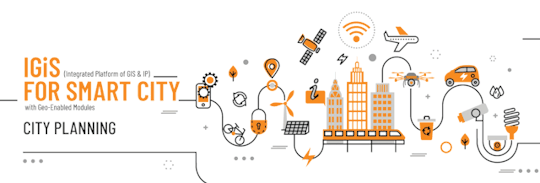
Education and Research: GIS is increasingly utilized in education and research for visualizing and analyzing spatial data. It enables students and researchers to explore geographic relationships, conduct field studies, and enhance their understanding of various subjects.

Agricultural Management and Precision Farming: Farmers leverage GIS to optimize agricultural practices by analyzing soil conditions, crop health, and weather patterns. Precision farming techniques, facilitated by GIS, contribute to increased crop yields and sustainable farming practices.
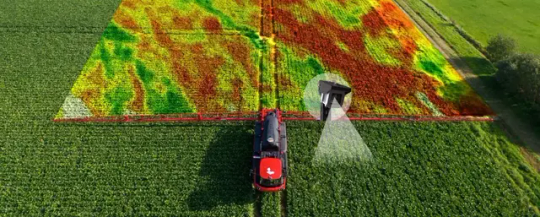
Real Estate and Property Management: In the real estate sector, GIS aids in property mapping, land valuation, and site selection. It provides real estate professionals with valuable insights into spatial relationships, market trends, and optimal development opportunities.
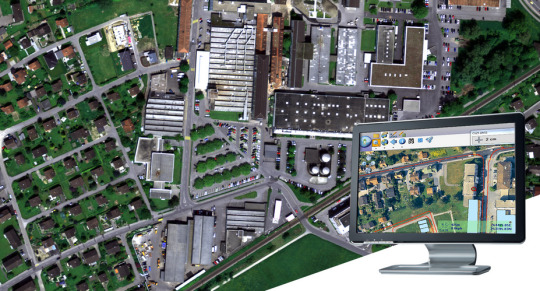
Tourism and Recreation: GIS enhances the tourism industry by providing interactive maps, route planning, and location-based information. It assists tourists in exploring destinations, finding attractions, and navigating efficiently.
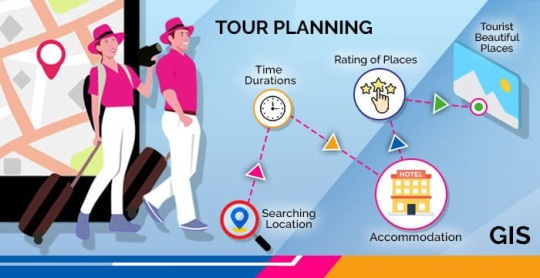
The broad and varied involvement of GIS in our daily lives underscores its significance as a technology that not only facilitates geographic data analysis but also contributes to the efficiency, safety, and interconnectedness of modern society. As GIS applications continue to evolve, their impact on daily activities is expected to further expand and refine.
#gis#architectdesign#architecture#city#education#geographic information system(gis)#geographical indication
14 notes
·
View notes
Text
geospatial data services Philippines,
High-Performance Geospatial Processing: Leveraging Spectrum Spatial
As geospatial technology advances, the volume, variety, and velocity of spatial data continue to increase exponentially. Organizations across industries—ranging from urban planning and telecommunications to environmental monitoring and logistics—depend on spatial analytics to drive decision-making. However, traditional geospatial information systems (GIS) often struggle to process large datasets efficiently, leading to performance bottlenecks that limit scalability and real-time insights.
Spectrum Spatial offers a powerful solution for organizations seeking to harness big data without compromising performance. Its advanced capabilities in distributed processing, real-time analytics, and system interoperability make it a vital tool for handling complex geospatial workflows. This blog will delve into how Spectrum Spatial optimizes high-performance geospatial processing, its core functionalities, and its impact across various industries.
The Challenges of Big Data in Geospatial Analytics
Big data presents a unique set of challenges when applied to geospatial analytics. Unlike structured tabular data, geospatial data includes layers of information—vector, raster, point clouds, and imagery—that require specialized processing techniques. Below are the primary challenges that organizations face:
1. Scalability Constraints in Traditional GIS
Many GIS platforms were designed for small to mid-scale datasets and struggle to scale when handling terabytes or petabytes of data. Legacy GIS systems often experience performance degradation when processing complex spatial queries on large datasets.
2. Inefficient Spatial Query Performance
Operations such as spatial joins, geofencing, and proximity analysis require intensive computation, which can slow down query response times. As dataset size grows, these operations become increasingly inefficient without an optimized processing framework.
3. Real-Time Data Ingestion and Processing
Industries such as autonomous navigation, disaster management, and environmental monitoring rely on real-time spatial data streams. Traditional GIS platforms are often unable to ingest and process high-frequency data streams while maintaining low latency.
4. Interoperability with Enterprise Systems
Modern enterprises use diverse IT infrastructures that include cloud computing, data warehouses, and business intelligence tools. Many GIS solutions lack seamless integration with these enterprise systems, leading to data silos and inefficiencies.
5. Managing Data Quality and Integrity
Geospatial data often comes from multiple sources, including remote sensing, IoT devices, and user-generated content. Ensuring data consistency, accuracy, and completeness remains a challenge, particularly when dealing with large-scale spatial datasets.
How Spectrum Spatial Optimizes High-Performance Geospatial Processing
Spectrum Spatial is designed to address these challenges with a robust architecture that enables organizations to efficiently process, analyze, and visualize large-scale geospatial data. Below are key ways it enhances geospatial big data analytics:
1. Distributed Processing Architecture
Spectrum Spatial leverages distributed computing frameworks to break down large processing tasks into smaller, manageable workloads. This allows organizations to handle complex spatial operations across multiple servers, significantly reducing processing time.
Parallel Query Execution: Queries are executed in parallel across multiple nodes, ensuring faster response times.
Load Balancing: Workloads are dynamically distributed to optimize computing resources.
Scalable Storage Integration: Supports integration with distributed storage solutions such as Hadoop, Amazon S3, and Azure Data Lake.
2. Optimized Spatial Query Processing
Unlike traditional GIS platforms that struggle with slow spatial queries, Spectrum Spatial utilizes advanced indexing techniques such as:
R-Tree Indexing: Enhances the performance of spatial queries by quickly identifying relevant geometries.
Quad-Tree Partitioning: Efficiently divides large spatial datasets into smaller, manageable sections for improved query execution.
In-Memory Processing: Reduces disk I/O operations by leveraging in-memory caching for frequently used spatial datasets.
3. High-Performance Data Ingestion and Streaming
Spectrum Spatial supports real-time data ingestion pipelines, enabling organizations to process continuous streams of spatial data with minimal latency. This is crucial for applications that require real-time decision-making, such as:
Autonomous Vehicle Navigation: Ingests GPS and LiDAR data to provide real-time routing intelligence.
Supply Chain Logistics: Optimizes delivery routes based on live traffic conditions and weather updates.
Disaster Response: Analyzes real-time sensor data for rapid emergency response planning.
4. Cloud-Native and On-Premise Deployment Options
Spectrum Spatial is designed to work seamlessly in both cloud-native and on-premise environments, offering flexibility based on organizational needs. Its cloud-ready architecture enables:
Elastic Scaling: Automatically adjusts computing resources based on data processing demand.
Multi-Cloud Support: Integrates with AWS, Google Cloud, and Microsoft Azure for hybrid cloud deployments.
Kubernetes and Containerization: Supports containerized deployments for efficient workload management.
5. Seamless Enterprise Integration
Organizations can integrate Spectrum Spatial with enterprise systems to enhance spatial intelligence capabilities. Key integration features include:
Geospatial Business Intelligence: Connects with BI tools like Tableau, Power BI, and Qlik for enhanced visualization.
Database Interoperability: Works with PostgreSQL/PostGIS, Oracle Spatial, and SQL Server for seamless data access.
API and SDK Support: Provides robust APIs for developers to build custom geospatial applications.
Industry Applications of Spectrum Spatial
1. Telecommunications Network Planning
Telecom providers use Spectrum Spatial to analyze signal coverage, optimize cell tower placement, and predict network congestion. By integrating with RF planning tools, Spectrum Spatial ensures precise network expansion strategies.
2. Geospatial Intelligence (GeoInt) for Defense and Security
Spectrum Spatial enables military and defense organizations to process satellite imagery, track assets, and conduct geospatial intelligence analysis for mission planning.
3. Environmental and Climate Analytics
Environmental agencies leverage Spectrum Spatial to monitor deforestation, air pollution, and climate change trends using satellite and IoT sensor data.
4. Smart City Infrastructure and Urban Planning
City planners use Spectrum Spatial to optimize traffic flow, manage public utilities, and enhance sustainability initiatives through geospatial insights.
5. Retail and Location-Based Marketing
Retailers analyze customer demographics, foot traffic patterns, and competitor locations to make data-driven site selection decisions.
Why Advintek Geoscience?
Advintek Geoscience specializes in delivering high-performance geospatial solutions tailored to enterprise needs. By leveraging Spectrum Spatial, Advintek ensures:
Optimized geospatial workflows for big data analytics.
Seamless integration with enterprise IT systems.
Scalable infrastructure for handling real-time geospatial data.
Expert guidance in implementing and maximizing Spectrum Spatial’s capabilities.
For organizations seeking to enhance their geospatial intelligence capabilities, Advintek Geoscience provides cutting-edge solutions designed to unlock the full potential of Spectrum Spatial.
Explore how Advintek Geoscience can empower your business with high-performance geospatial analytics. VisitAdvintek Geoscience today.
Post navigation
Previous post:Natural Resource Conservation and Climate Risk Assessment with Geospatial IntelligenceSearch
Blog Categories
Geospatial Addresses(2)
Geospatial Boundaries(1)
Location Data(1)
Location Intelligence(9)
MapInfo Pro(3)
News(1)
Points of Interest(1)
Spectrum Spatial(4)
Telecommunication(5)
Recent Posts
February 14, 2025High-Performance Geospatial Processing: Leveraging Spectrum Spatial…
February 14, 2025Natural Resource Conservation and Climate Risk…
February 14, 2025Advanced Location Intelligence for Critical Decision-Making…
Advintek a leading Geosciences software and location data provider leverages the strengths of MapInfo to deliver advanced spatial analysis and geospatial intelligence. We provide robust Geosciences platform for in-depth spatial analysis, mapping, and integration with a wide range of industries such as Insurance, Telecommunications, Energy & Utilities, Natural Resources, Banking and more.
+65 6428 6222
Quick Link
Home
Customer Highlights
Resource
Partner
Contact Us
#Location Intelligence#Geospatial Services#Spectrum Spatial#MapInfo Pro & Spectral Analytics#Real‑Time Location Data#GIS Consulting & Training
0 notes
Text
How Meta (Facebook) is Building Its Metaverse Infrastructure
Introduction
When Mark Zuckerberg announced Facebook's rebrand to Meta in late 2021, he wasn't just changing a company name he was signaling a massive shift in digital infrastructure investment. The tech giant's ambitious vision for the metaverse represents one of the largest infrastructure projects in tech history, requiring revolutionary advancements in hardware, networking, and computing power. Let's explore how Meta is creating the foundation for its virtual universe and what it means for the future of digital interaction.
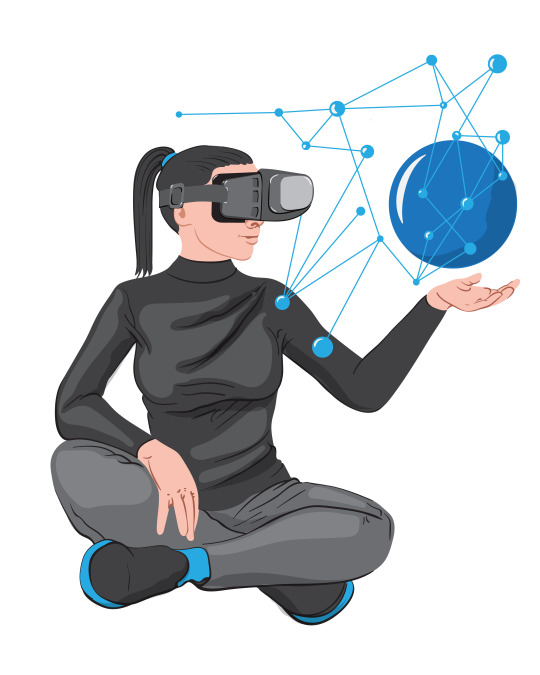
The Backbone: Computing Power and Data Centers
Meta's metaverse dreams begin with raw computing muscle. The company has dramatically expanded its data center footprint, investing billions in specialized facilities designed specifically for the computational demands of immersive 3D worlds.
Unlike traditional web services, metaverse environments require real-time rendering, physics simulations, and support for thousands of simultaneous users—all while maintaining low latency. To meet these demands, Meta has been upgrading its data centers with specialized AI processors and graphics hardware optimized for spatial computing.
The company recently unveiled its AI Research SuperCluster (RSC), which it claims is among the world's fastest AI supercomputers. This computing powerhouse isn't just for current AI tasks—it's being positioned as critical infrastructure for metaverse development, capable of training the massive models that will power everything from realistic avatars to intelligent virtual assistants.
Solving the Latency Challenge: Edge Computing and Network Infrastructure
For the metaverse to feel real, interactions must be nearly instantaneous. Even small delays between user actions and visual feedback can break immersion and cause physical discomfort. This creates a massive technical challenge that Meta is addressing through strategic investments in edge computing and network architecture.
The company has been quietly building out edge computing nodes closer to users, reducing the physical distance data must travel. Additionally, Meta has invested in subsea cable projects like 2Africa and Echo, expanding global internet backbone capacity to support the massive data transfers the metaverse will require.
Perhaps most interesting is Meta's work on "Project Aria," which explores how distributed computing between devices and the cloud can reduce latency. By splitting computational tasks—performing some calculations on headsets while offloading more intensive processes to nearby servers—Meta aims to deliver responsive experiences even with limited on-device processing power.
Creating the Interface: Hardware Development
While software and servers form the metaverse's foundation, hardware is where users will actually experience it. Meta's acquisition of Oculus in 2014 (for $2 billion) now seems prescient, giving the company a significant head start in VR hardware development.
The Quest headset line has evolved to become increasingly powerful while remaining affordable and wireless—crucial factors for mass adoption. But Meta's hardware ambitions extend far beyond current VR headsets. The company's Reality Labs division is working on multiple next-generation interfaces:
Lightweight AR glasses that overlay digital information on the physical world
Haptic gloves that let users "feel" virtual objects
Neural interfaces that can detect subtle muscle movements for more natural control
Spatial audio systems that create convincing 3D soundscapes
Project Cambria (now released as the Quest Pro) represented Meta's push toward higher-end mixed reality, incorporating eye tracking, face tracking, and improved passthrough technology—all essential components for creating presence in virtual environments.
Building the Digital Foundation: Software Infrastructure
Underpinning Meta's metaverse is a complex software ecosystem designed to handle everything from avatar creation to virtual economies. The company has developed several key platform components:
Horizon Worlds serves as Meta's social VR platform where users can create and explore virtual spaces. While still developing, it represents the company's vision of user-generated content driving metaverse growth.
Presence Platform provides developers with tools to blend virtual and physical reality, including scene understanding, spatial anchors, and interaction SDKs.
Avatar system allows persistent digital identities across Meta's apps, with increasingly realistic appearances and expressions.
Meta has also been acquiring companies with specialized metaverse technology, such as Within (VR fitness), Supernatural (VR fitness), and BigBox VR (social VR gaming)—integrating their innovations into the broader infrastructure.
The Interoperability Challenge
Despite investing billions in proprietary technology, Meta has publicly committed to metaverse interoperability—the idea that virtual worlds should connect rather than exist as isolated islands. The company joined the Metaverse Standards Forum alongside competitors like Microsoft, helping establish protocols for identity, payments, and virtual assets.
This approach recognizes a crucial reality: no single company can build the entire metaverse alone. By establishing open standards while maintaining ownership of key infrastructure components, Meta aims to influence the metaverse's direction while ensuring its central role in its development.
Ethical Infrastructure and Trust & Safety
Building metaverse infrastructure isn't just about technology—it's also about creating systems to ensure safety, privacy, and responsible use. Meta has established a $50 million XR Programs and Research Fund partly focused on developing ethical guidelines and safety features.
The company is developing tools like personal boundaries to prevent harassment in virtual spaces and content moderation systems designed specifically for 3D environments. These "trust and safety" elements represent critical but often overlooked infrastructure components.
The Economic Foundation: Payments and Commerce
A self-sustaining metaverse requires robust economic systems. Meta has been building financial infrastructure through several initiatives:
Horizon Marketplace enables creators to sell virtual items
Meta Pay (formerly Facebook Pay) provides payment processing
Digital collectible support allows for NFT displays on Instagram and Facebook
While Meta's cryptocurrency efforts (formerly Libra/Diem) faced regulatory challenges and ultimately shut down, the company continues exploring digital payment solutions that could power metaverse economies.
Conclusion
Meta's metaverse infrastructure represents one of the most ambitious digital projects in history, spanning hardware, networking, computing, and platform development. While significant technical, ethical, and business challenges remain, the company has demonstrated its commitment through unprecedented investment—reportedly over $10 billion annually.
The success of this massive infrastructure project remains uncertain. Questions about user adoption, regulatory oversight, and competition from other tech giants loom large. However, what's clear is that Meta isn't just talking about the metaverse—it's building the foundations it believes will support the next generation of digital experiences.
Whether Meta's vision of the metaverse becomes reality or evolves into something different, the infrastructure investments being made today will likely shape digital interaction for decades to come.
#mobile game development#gaming#multiplayer games#nft#metaverse#game#vr games#blockchain#unity game development
1 note
·
View note
Text
Episode 8: Burned Out
Reading the transcript instead of listening to this one, as I still do not have international data and my headphones broke.
I have a penchant for Hill Top Road episodes. The presence and details of all the interactions with the different Fears and people is just great. Maybe this is why I liked the Eye so much, just because I liked learning about these things. I just mistook the reason.
It's not because I sought knowledge for it's own sake, it's because the concept fascinated me. The madness had to be my own.
Ivo here's work in wiring reminds me for some reason of that one video of that guy redoing an old lady's wiring and correctly guessed that her son, who did the (very bad) wirings' house burnt down.
Yeah sure bro go to a half-built house in the middle of the Oxfuck suburbs in the middle of the night and do wiring. Alone. That sounds safe and normal and cozy warm.
Damn do I hope this guy's gay
Oh fuck it's near South Park. That explains a lot.
Look, no offense to construction workers and I'm sure they're not all like this, but from what I've seen they leave a lot of nails just sitting around. I was tearing up my grandma's carpet once to have it replaced and there was just. Stuff under there. And my brother once made like 100 bucks with his magnets cleaning up people's yards after they'd had their roofs redone.
The tree! Oh, the beautiful tree. It's so infused and congested with Fear. I would sleep in it even if it gave me nightmares for the rest of my life. I bet it gave great fruit while it still lived lol
Reminds me of the tree from the Chronicles of Narnia, the one they made into a wardrobe. So much ancient power, I'm fucking salivating. God that sounds weird.
Anyway, the mention of the shadows makes me think of the Dark.
Hmm yes very normal guy this Raymond Fielding
Bet bro didn't check the dates on those papers
Why the fuck is Fielding here. What point does his presence serve. Like why does he have to be the inciting incident he is not that scary in and of himself.
Oh shit, this guy's got history. Fear of schizophrenia, fear of not knowing what's real... I mean, an awful disease. But. I like.
I self-diagnosed myself with schizophrenia at like. Age 7. I don't have schizophrenia, fucking shocker.
Ivo's dad reminds me of Montague in a way, each locked in a room working their life away in service of a fear, however aware of it they are, until their wife disappears in one way or another and their kid is left traumatized and is later touched by Fear themself in adulthood, often after the death of their father. Huh. Sure it doesn't signify anything.
Fractals are fucking cool, I would study them myself if I wasn't both on the run from the law at the moment and no good at math.
He's right about the hands.
I wonder if he ever saw the hallways.
Bro was just trying to see the hands for real, pity they were too sharp for him.
Isn't a huge part of construction work like. Spatial awareness. Fuckin dumbass.
This man is straight and I am in shambles
That's a pretty bad concussion if he had to stay in the hospital for two days, maybe it'll lead to further issues - or perhaps it's just because he lives alone and won't be able to care for himself with the injury.
I love the word diocese, it reminds me of eglantines
Agnes is so fucking cool she would make a great fruit
wait how the fuck did she get an education
Wonder who the house belongs to now. The statement says the legal troubles over ownership were resolved, but how?
Bro doesn't believe in ghosts. Such an L move
Too bad about the tree, but it does make sense.
This apple reminds me of the Tree of Growth cult. A beautiful apple in a horrible place, seemingly engulfed with fear, but it shrivels away to nothing upon closer inspection.
This continues to confirm my hypothesis that Fears go after people who are less likely to be believed. This of course increases the psychological trauma of the experience but also lowers the likelihood that the Fears' true nature will be discovered. Very clever.
This is a good statement, a great introduction to the problem of Hilltop Road. Jude Approved!
5 notes
·
View notes
Text
From 2D to BIM: Upgrading Your Architectural Design Process
Are you still stuck in the 2D era?
Upgrade your architectural design process to the cutting-edge technology of Building Information Modelling (BIM). This game-changing innovation is transforming the architecture industry, and it's time to join the revolution.
The Limitations of 2D Design
Traditional 2D architectural design has served us well, but it's time to acknowledge its constraints. 2D designs lack the depth and detail required for modern construction projects. if it's fail to provide a comprehensive understanding of the building's components, leading to errors, miscommunications, and costly rework.
Lack of Clarity: 2D designs can be ambiguous, leading to misunderstandings and misinterpretations.
Inadequate Visualization: 2D designs struggle to convey complex spatial relationships and design intent.
Inefficient Collaboration: 2D designs make it challenging for stakeholders to collaborate and communicate effectively.
Error-Prone: 2D designs are more susceptible to human error, leading to costly rework and delays.
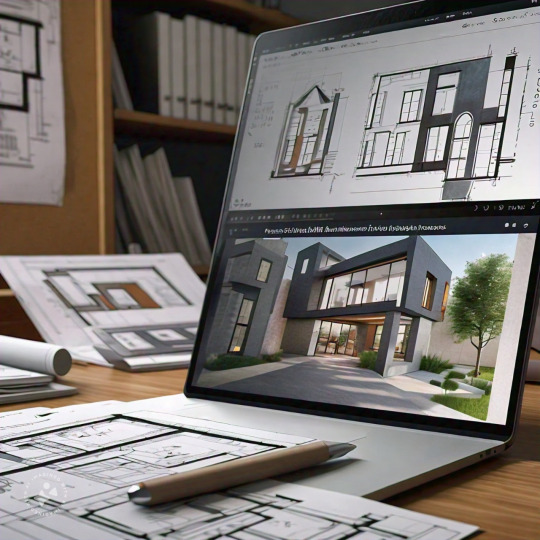
Enter BIM: The Future of Architectural Design
BIM is more than just a design tool – it's a collaborative platform that unifies architecture, engineering, and construction professionals. With BIM, you can create detailed, data-rich models that simulate real-world performance. This revolutionary technology enables:
Improved Collaboration: Stakeholders can access and contribute to the design process in real-time, ensuring everyone is on the same page.
Enhanced Visualization: 3D models and simulations facilitate better understanding and communication, reducing errors and miscommunications.
Increased Accuracy: Automated clash detection and interference checking minimize errors, ensuring a more efficient design process.
Efficient Project Management: Real-time tracking and analysis streamline the construction process, reducing delays and cost overruns.
Seamless Transition with Architectural BIM Services
Upgrading to BIM doesn't mean starting from scratch. Our expert Architectural BIM Services will guide you through a seamless transition, leveraging your existing designs to create rich, data-driven models. Our comprehensive services include:
Architectural BIM Modeling: Transforming 2D designs into detailed, interactive 3D models, enabling enhanced visualization and collaboration.
Architecture CAD Drawing: Converting traditional CAD files into BIM-compatible formats, ensuring a smooth transition.
Architectural 3D Modeling Services: Creating immersive, photorealistic visualizations, enhancing design communication and stakeholder engagement.
Architectural 3D Rendering Services: Generating stunning, high-resolution images and animations, perfect for marketing and presentation purposes.
Benefits of BIM
Enhanced Creativity: Explore new design possibilities with data-driven models, unlocking innovative solutions.
Improved Productivity: Streamline your workflow with automated processes, reducing design time and costs.
Increased Competitiveness: Stand out with cutting-edge technology and innovative solutions, attracting clients and projects.
Better Decision-Making: Data-driven models enable informed decisions, reducing risks and improving project outcomes.
Sustainability: BIM facilitates sustainable design, reducing environmental impact and promoting green building practices.
Implementing BIM in Your Practice
Upgrading to BIM requires a strategic approach. Here's a step-by-step guide to ensure a smooth transition:
Assess Your Current Workflow: Identify areas for improvement and determine the best approach for your practice.
Choose the Right BIM Software: Select a software that aligns with your needs and skill level.
Train Your Team: Invest in comprehensive training to ensure a seamless transition.
Develop a BIM Execution Plan: Establish clear goals, processes, and standards for your BIM implementation.
Start Small: Begin with a pilot project to test and refine your BIM workflow.
The architectural design process is evolving, and BIM is leading the charge. Don't let outdated design processes hold you back. Embrace the future of architecture with our expert BIM services. Discover the advantages of enhanced creativity, improved productivity, and increased competitiveness. Join the BIM revolution today and transform your architectural design process. Contact us to learn more about our Architecture BIM Services and take the first step towards a more efficient, collaborative, and innovative future.
#architecture#interiors#bim#construction#autocad#architectdesign#architecturalbimservices#modern architecture
2 notes
·
View notes
Text
Personnel File: Manor Workers
((To readers with █████-█ Clearance, some data has been deleted. It seems someone is not wanting them to be labeled as a Group of Interest))
File Number: 6341
Entities of Interest: Manor Workers
Threat Level: Non-existent to Dangerous
Anomalous?: Yes
Ties to other Groups of Interest?: Yes, Brunshire Academy for the Anomalously Gifted.
Description: The entities that make up the Manor Workers are just that, employees and workers of SCP-3992, "The Manor". They come in many differing forms and with different roles to fill. Their exact count is unknown, as there as little as five seen working but there have been reports of up to fifty personnel spotted on the premises.
Most of the personnel were present in 3992 before it was manipulated by Overseers Two and Four. Thus, they seemed to have an immunity from becoming lost or disoriented from the constant spatial manipulation. Additionally, those who were present appear to have been deemed "worthy" and won't be harmed by the Manor. Visitors need to be more careful and often cannot be told apart from friend or foe.
The following is a list of the more frequent workers seen:
Mr. Deeds - SCP 662-1 in the flesh, albeit now as a werewolf. He has gained more autonomy following his clapper being attached to the bell. However, it appears he's staying on his own, and not necessarily because he's duty-bound to the original ringer. Head of the cleaning crew.
-
Omrich Varron - The eldest butler prior to Mr. Deeds' arrival. He is often found delivering sweets and snacks to the people in the Manor. He is serious yet kind, and is always willing to aid the man who surpasses him in one day, Mr. Deeds. Former head butler, now just a personal aid
-
Teala Vasquez - Gruff and serious, Teala Vasquez is the head maid of the Manor. Armed with a hidden shotgun and a legacy of murder (being the daughter of the infamous Murderous Maid serial killer), she executes her duties with meticulous and precise fashion.
-
Halrin Eustafed - Skittish and clumsy, Halrin is the only servant of the Manor who has been confined to working in one section of the Manor, that being the kitchen, as he seems to be unaffected by any outside problems that would ordinarily cause problems. Turned into a bird on accident.
-
Donna Sue - A spectre of an old maid. She passed due to the Time Wrym imprisoning the Manor in a time loop. She was caught between a plane of life and death, and has been tethered to the Manor unable to move on.
-
Percival "Percy" Wiggins - A young man and head mechanic who seems to be bossed around by his tools. He genuinely believes them to be talking to him, and others have claimed that a faint whispering can be heard from them.
-
"Nico" - Overseer Four's former factotum named [DATA DELETD], he now operates as a cuddly feline butler who likes to play with yarn, fight off crows, and hunt the gardens for mice. Petting is encouraged.
-
Eleanor - A mysterious young woman who is often not found without her jade tea cup up to her lips. She appears often without warning and disappears just as quickly. Scans show she's not anomalous in regards to spatial traveling. She is always in charge of tea time and the Parlours.
-
Eliza Piscanzo - A bubbly lass who is often found with dirt all over her. She's the enthusiastic gardener, and is almost always located in the back, trimming hedges or gathering bouquets. Has a fear of statues.
-
Harle Eros - A muscular bellboy and room service captain for guests staying at the Manor. He can be found delivering food or tidying up the many sleeping quarters littered throughout the Manor. Apparently in a relationship with one of Overseer Four's sons, █,█,█,█,█
-
3008-2 - An Infinite Ikea employee that came to be from and Insurgent being transformed by [DATA DELETED]. Works in the basement
2 notes
·
View notes
Text
South African researcher on the management of communal land
By
Wonga Masiza
Researcher, Agricultural Research Council
To understand the extent, causes and impact of communal land change, we analysed a series of historical satellite images from 1989 to 2019 and conducted interviews with locals. Instead of interviewing experts and leaders, the study measured the most common perceptions among community members.
As far as we know, this study is one of the first in South Africa to combine satellite data and local perceptions. This offered a more complete view of communal land change, and valuable insights on its impacts.
We suggested some ways in which this land could be managed better to provide ecosystem services and livelihoods.
Snippet
Satellite imagery from 1989 to 2019 revealed increases of the sweet thorn tree (Vachellia karroo) by 25% and the residential area (2.5%). It showed declines of grazing land (18%), cropland (9.6%) and dams (1.1%).
The land can be better managed through interventions by village committees, tribal authorities and extension services, and by following spatial planning and land use guidelines..
Most respondents (over 80%) noted the encroachment of the sweet thorn tree on grazing land and abandoned cropland. They said contributing factors were a decrease in fuelwood harvesting due to increased reliance on electricity, the abandonment of cropland (providing habitat for the sweet thorn) and seed dispersal caused by unrestricted movement of animals. Many saw the tree as beneficial because goats like to eat it and it makes good fuel. Others were concerned that this tree was invading productive agricultural land and causing a loss of biodiversity. They mentioned increased scarcity and disappearance of medicinal and culturally significant plants.
#local knowledge#traditional knowledge#endemic knowledge#indigenous knowledge#land management#communal land#south africa#managing land that belongs to everyone
2 notes
·
View notes
Note
send 👫 for a reunion starter

After the conclusion of Clemens' debacle, and his and Guinan's subsequent departures, the android repositioned the transreceiver in his supposed prototypical device for the horseless carriages and settled himself at the desk, monitoring the instrument's workings deliberately. Assiduously, he observed the rhythmic oscillations of the metal indicator, which functioned in a similar fashion as an analogue seismograph. Thus far, his device had not measured any time shifts, and would not for the next 39 minutes...
A long-awaited, arrhythmic scratching sound instantaneously tore his attention to the contraption. Excitedly, the pen attached to the end of the indicator recorded the occurrence — the device finally measured the time shift he had been anticipating —, and based off of the particulars printed on the sheet of paper, he could accurately determine the epicentre of the spatial distortion. Data consulted a map of the town to confirm the location, and without a moment's hesitation, he leapt to his feet and vacated his room. He navigated himself down a flight of stairs with mathematical precision and hurried outside where he supplied the bellboy, Jack, with sufficient 19th century currency to have him procure a carriage, preferably drawn by two equines — to multiply the carriage's power.
The ever-efficient hotel employee immediately scurried off to the stables and returned within several minutes, gesturing gleefully at the wagon he had snatched from an agitated colleague. Prior to mounting the box, Data expressed his gratitude for his services and pressed an additional sum of money in the boy's hand. He had never rode on horseback, let alone piloted a vehicle that was pulled by two of them, but he had judged it advantageous to observe others operate this form of transportation, in case he would relay on its services in the foreseeable future — he was glad he had pursued that particular endeavour.
Data armed himself with the reins and managed to set the equines into motion, gently instructing the animals to accelerate. The terminal words of farewell that emanated from the bellboy were left behind in a cloud of dust...
The carriage careened through the streets, teetering uncomfortably toward his destination: the local hospital. And it was not until he was in close proximity of the aforementioned facility that his positronic subprocessors sensed the familiar hum of 24th century technology, or rather, the wavelengths of a tricorder that was broadcasting signals on all frequencies. While he narrowly circumvented a collision with another horse-drawn carriage, he inferred that the others must have successfully ferried themselves across the frontiers of time and were here to assist him.

When the carriage swept around a corner, the tricorder transmission started to grow stronger and more prominent; his conjecture was confirmed when he sighted the others filing out of the hospital, and he promptly surmised that the occurrence of the time shift might have been a joint effort between them and the two individuals with the ophidian. Unfortunately, he could not initiate his interrogation, for his friends appeared to have antagonised the local police force.
'Data!' Commander Riker's loud, sonorous voice lacerated through the air, alerting him, unnecessarily, of their presence.
The android pulled on the reins to render the equines stationary adjacent to the pavement, allowing his friends to embark the vehicle.
'Doctor,' Data said, his own voice extraordinarily tranquil. He extended his hand for to grab and join him on the box seat while the others clambered into the carriage. 'It is good to see you again.'
'Go, Data! Hurry!' Captain Picard ordered, an urgent accentuation vibrated in the words he had enunciated.
'Aye, sir,' he replied compliantly, providing the horses with the objective to proceed down the street, with the intention to escape the police and take temporary refuge in the countryside until the coast was clear and they were certain no reinforcements would be ambushing them upon their return...
#dannsa-dotair#verse // to thine own self be true; and it must follow as the night the day thou canst not then be false to any man#welcome back! also have this time's arrow reunion starter; we could potentially turn it into an au where they aren't able to use the --#-- snake cane to get back to the 24th century heh#them ending up having to perform the shakespeare play they were pretending to rehearse in that irish lady's apartment >:)#also them chilling in the countryside in their 19th century outfits having a picnic or something asdfghjkl no jk..... unless.......?
2 notes
·
View notes